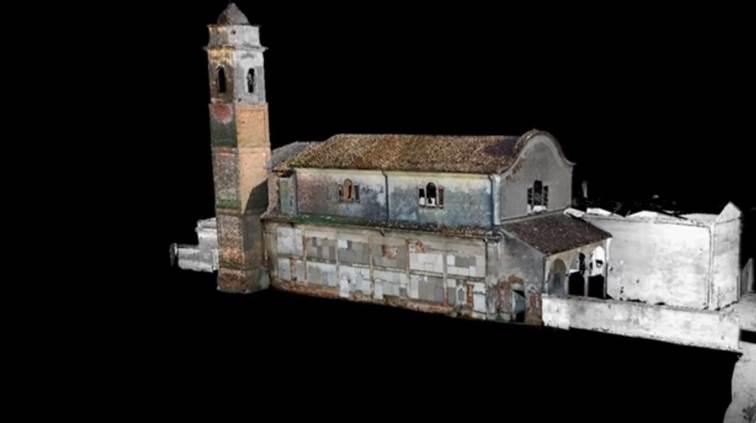
When we think of culture, the topics of research and innovation are not the first that come to mind.
However, they are indispensable in preserving our cultural heritage, as well as in finding new ways of presenting it to various audiences.
The JRC lends its expertise to this endeavour, from the safety and security of buildings, through three-dimensional (3D) laser scanning technologies to neutron resonance analysis for archaeological applications.
Preserving cultural significance while enhancing safety and security of buildings
Many of the buildings associated with Europe's cultural heritage (such as churches, towers, castles and medieval villages in the Mediterranean region) are characterised by its fragility compared to modern buildings, and its vulnerability to earthquake events.
The recent earthquakes in central Italy have shown the grave consequences that historical buildings can suffer, and how urgent and important it is to adopt a methodology to improve the stability and seismic protection of cultural heritage.
The JRC’s European Laboratory for Structural Assessment (ELSA) in Ispra, Italy, has a long history of work in the field of cultural heritage, combining research and interventions on monumental buildings damaged by earthquakes.
The JRC characterises the behaviour of historical structures during earthquake events and helps define and assess retrofitting and restoration methods.
Examples include work carried out on the reconstruction of the Gemona and Venzone cathedrals after the 1976 Friuli earthquake.
The JRC conducted a study on the Geraci Palace in Palermo to develop a methodology for the structural strengthening of monumental buildings and to assess the extent to which the numerical models can predict the earthquake response of this kind of structure.
Sometimes the JRC is called upon to intervene in culturally significant buildings that had already been damaged centuries earlier, as was the case of the São Vicente de Fora monastery in Lisbon, which still showed the damages suffered in the 1755 earthquake.
Work included an assessment of the seismic vulnerability and an analysis of possible retrofitting solutions, through on-the-spot and laboratory testing and numerical modelling.
Finally, the three-year Innovative Stability Techniques for the European Cultural Heritage (ISTECH) project carried out from 1997 and 1999 developed and assessed, both numerically and experimentally, a new seismic protection method for ancient structures.
In particular, it developed devices using shape memory alloys to improve the stability of historical buildings avoiding overly invasive techniques which could undermine the integrity of the original structure.
The retrofitting of the bell-tower of the San Giorgio Church in Trignano was the pilot application of this project.
The same technique was applied for the retrofitting of the Saint Francis Cathedral in Assisi, following the damage suffered after the 1997 earthquake.
The ELSA laboratory also developed the Fast Impact Hammer Testing (FIHT) methodology which can help assess structural vulnerabilities and the effectiveness of interventions.
From nuclear plants to churches – 3D laser scanning
JRC researchers have developed a 3D laser scanning technology that can be transported to the damaged zone in a backpack.
Originally developed for nuclear safeguards, this technology can be applied for the detailed 3D mapping of damaged historical buildings, which is the basis for damage assessment and the planning and monitoring of reconstruction efforts.
This technology uses a mobile laser scanner that continuously takes distance measurements while the scanner moves through the environment.
The software merges all measurements into a single 3D map which can be analysed according to the needs of the specific tasks. The system works indoors and can be mounted on any mobile platform, such as backpacks, cars or drones.
Neutron resonance analysis for archaeological applications
The Geel Linear Accelerator (GELINA), an electron accelerator-driven neutron facility located at the JRC site in Geel, Belgium, is normally used to study the interaction of neutrons with materials that are used in nuclear reactors.
JRC researchers have used this facility in an innovative way: they developed a non-destructive analysis technique called Neutron Resonance Analysis (NRA) to determine the elemental composition of objects.
NRA has been employed to reveal the secrets of archaeological artefacts such as, for example, a collection of bronze statuettes assembled by Count Corazzi of Cortona, Italy, which were assumed to be of Etruscan origin.
It turned out that several items were fakes or imitations made during the Renaissance period. Several other objects (such as a series of Roman bronze water faucets, socketed axes and swords of the Middle Bronze Age) were investigated to learn more about their fabrication methods, origin and usage.
Innovation and Cultural Heritage conference
On 20 March the European Commission organised a high-level Horizon 2020 conference, which showcased the most promising innovations in the field of cultural heritage, supported by European policies and funds.
On that occasion the JRC published the report Are capitals the leading cultural and creative cities in Europe?, which presents data from the Cultural and Creative Cities Monitor that looks at the performance of 168 "Cultural and Creative Cities" in Europe.
This report is the first of the new 'Socio-economic regional microscope series', which will deliver policy-relevant stories and narratives using socio-economic data and maps at regional and local levels.
Related Content
JRC publication: Are capitals the leading cultural and creative cities in Europe?
Details
- Publication date
- 21 March 2018
